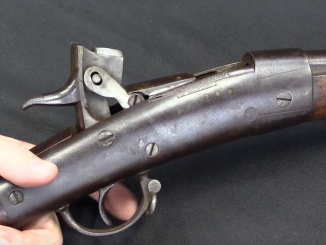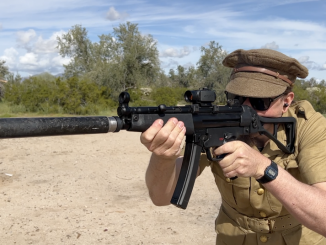In the early 2000s (specifically 2006/2007, I believe) US Delta Force decided to replace its .45 ACP 1911 pistols with something having a larger magazine capacity. After testing a number of different platform initially, they settled on two to purchase and fully evaluate. These were the STI 2011 (a double-stack 1911 platform) and the Glock 22, both in .40 S&W caliber.
The unit ended up keeping the Glocks and returning the STI pistols to their manufacturer as unsatisfactory, largely because of magazine reliability issues. The STI 2011 of that period was designed around a .45ACP cartridge length, and the magazines were significantly longer front to back than needed for standard .40 S&W ammunition. This was not a problems for competition shooters, who could load their cartridges to a long OAL to properly fit the magazines, but Delta did not have this option, since they needed ammunition that would also fit the Glocks.
As you might expect, there is a lot less PR value in having your pistols rejected by Delta than in having them purchased by Delta. When the guns were returned to STI, they were subsequently sold off as simply used .40 caliber 2011s, without mention of their Delta provenance. Some people who knew what they were snapped them up, but some went to people who may still not recognize the provenance of what they have…




2011s are still stuck with giant magazines and grips dictated by the .45ACP form factor. Since the grip frame (mag well) is modular / separate, I’d love to see a manufacturer design one to accept common, reliable 9mm-size 9mm magazines.
I can’t say much for STI’s testing – this problem should have been found and fixed with a modified magazine and magazine well before they ever got out of their hands. And if the company then said, that would cost too much for a limited order, they should have never bid on the contract. Although I think that the fix would have appealed to competition shooters as well by improving their reliability without having to special load ammunition.
Save a penny to omit mention of “unnoticeable defects,” pay damages in pounds of angry customers. Reminds me a bit of the original Ford Pinto problem, where Ford thought nobody would be STUPID ENOUGH to crash a fully loaded HEAVY dump truck into the compact car’s uninsulated fuel tank in urban traffic. After that fiery accident, lots of people tried to get rid of the Pinto in ridiculous ways (including ditching them off docks and bridges). I could be wrong on some details.
“(…)Ford thought nobody would be STUPID ENOUGH to crash a fully loaded HEAVY dump truck into the compact car’s uninsulated fuel tank in urban traffic.(…)”
No. They were aware of that crash might lead to gasoline leak, but elected to not do anything about it, as they deemed that it would cost less to pay reparations, or as https://www.tortmuseum.org/ford-pinto/ put it.
Ford’s cost-benefit analysis showed it was cheaper to endure lawsuits and settlements than to remedy the Pinto design.
https://youtu.be/OEDAGNYYa1o
Details… Meh, enjoy life.
I had a CZ 52 that had been converted to 9x19mm from the OEM 7.62X25 cartridge that had constant issues with the shorter cartridge. I could have loaded 147gr bullets to the correct LOA, if I was set up to hand load. Never had the chance to see if that did in fact solve its feeding issues.
What a spiral of history. Czechoslovak vz. 52 was derived from ČZ 482 which used 9×19 Parabellum cartridge (magazine capacity 8), see 1st photo from top http://www.vhu.cz/exhibit/cs-pistole-cz-482/
“(…)STI 2011 of that period was designed around a .45ACP cartridge length, and the magazines were significantly longer front to back than needed for standard .40 S&W ammunition.(…)”
Now I am wondering about magazines for P16-40 automatic pistols https://modernfirearms.net/en/handguns/handguns-en/canada-semi-automatic-pistols/para-ordnance-p14-45-eng/
it was also derived from weapon designed for .45 Auto cartridge. Was magazine there adjust for different cartridge length?
According to Maj. George Nonte in his 1971 book Pistolsmithing (now available free online), when converting a 1911 or other self-loading pistol to a cartridge with a shorter OAL than its original chambering, converting the magazine is the easy part.
First, you shorten the follower front-to-back. On a 1911, this is generally done by cutting off the rear downward “leg” of the follower, shortening the “shelf” by the appropriate amount, the spot-welding the “leg” back in place.
To avoid slop in the movement of cartridges and follower, the second step is to fabricate a spacer strip to go up the rear inside face of the magazine body. Nonte preferred mild steel, but in the modern era a strip of high-strength polymer would serve as well, and might even be somewhat self-lubricating.
To attach it, Nonte suggested brazing or spot-welding, or even epoxy. The top needs to be shaped to match the top of the rear magazine face, to ensure proper feeding. This is best done after it is firmly attached, to ensure that everything “matches up”.
This is such a simple “fix”, and one so well known among custom pistolsmiths for so many years, that it not being used by STI does not speak well of their engineering department.
cheers
eon
Maybe known among custom pistolsmiths. STI probably has had more like school/university trained engineers, that knew the theory but not not the dirty details of a 1911/2011 custom gun and what to look out for. Plus I bet management decided that the magazines were good enough. Well for a finicky competitio race gun they may well have been, but military use is a bit different from a safe square firing range, that you can leave any time to repair your pistol.
They used to (still do?) make a spacer/follower combo that uses a shorter follower and a magazine shaped spacer to fill in the extra length & allow use of short .40s & 9mm. I didn’t want to make long .40s for my STI & standards for the Glock, so I got these for all my STI .40 mags & I’ve used them for years with no issues.
Cheers for the shoutout to Kevin O’Brian/Weaponsman. 🙂 He used to comment on here form time to time as well.
I miss Weaponsman as well! Outstanding man and writer.